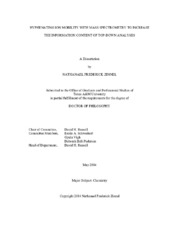| dc.description.abstract | Mass spectrometry (MS) has been established as important analytical tool in the
characterization of an array of analyte classes, including biological samples. However,
without hyphenation with other techniques, the approach has limitations to the
information that can be elucidated and the samples that can be analyzed. In an attempt
to overcome these limitations, separation is performed prior to MS analysis to aid in
alleviating sample complexity while dissociation is incorporated to increase the
information content. Here, we employ ion mobility (IM), a gas-phase separation
technique, to disperse product ions resulting from collision-induced dissociation (CID),
denoted as MS-CID-IM-MS, for top-down analysis for a variety of applications,
specifically, primary structure elucidation, disulfide bond identification, secondary
structure characterization, and polymer characterization.
First, the fundamental attributes of this approach and the resulting information
elucidated are investigated. Using this approach CID product ions are dispersed in two-dimensions,
specifically size-to-charge (IM) and mass-to-charge (MS), and the resulting
2-D data display greatly facilitates the top-down information contents; (i) charge state
specific trand lines, (ii) increased dynamic range, (iii) separation of overlapping ion
signals. The increase in peak capacity allows for detection of low abundant fragment
ions providing an increase in the primary sequence coverage and the confidence of ion
assignments as demonstrated by melittin and ubiquitin.
Second, this general approach is applied to the top-down analysis for a variety of applications. MS-CID-IM-MS is used for the structural characterization of disulfide linked protein ions by monitoring the ATD of the ion pre- and post-collisional activation. Similarly, this approach can also be used to distinguish product ion type as well as, in some cases, specific secondary structural elements, viz. extended coils or helices providing rapid identification of the onset and termination of extended coil structure in peptides as demonstrated by insulin B-chain. Detect of low abundant ion signals associated with cross-ring cleavages allows this approach to be extended to determine regiochemistry of glucose derived polymers. As demonstrated, the MS-CID-IM-MS approach is highly versatile owing to the information content gained upon dispersion of ions in two-dimensions, providing an effective increase in experimental dynamic range as well as providing conformational information. | en |


